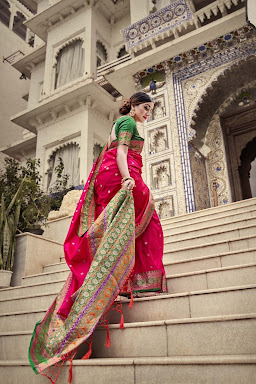The connection of saree with the life of woman
The most dominant dress in India is saree. Over 70% of Indian women wear saree if not daily but on specific occasions like festival and functions of family. Saree is the most wear cloth in India, as India women’s are so dedicated and devoted toward their traditional and culture.
Saree plays a vital role in India identities most of the women wear saree everyday on normal basis as well as on formal basis. One can see it as a business opportunity because the market capital of Indian sarees is over 400 billion rupees in 2018.
The first mention of saree was in the ‘Rig Vedas’. The origin of saree came from Indus Valley civilization. The journey of saree began from cotton and changes by the time. As we see it in many of the Mughal as well as in Indian history.
Every generation of women loves saree whether they are Indians or not saree is appreciated by each and every woman of the world. As people are exploring other cultures and traditions now saree and all the ethnic clothes of our culture is getting the recognition from everyone.
One of the most comfortable saree is cotton saree and one of the most expensive and event friendly saree is silk saree like Banarasi silk saree, Paithani silk saree etc. This type of saree is famous for his embroidery work on it which is done by hands.
The meaning of saree is “strap of cloth” in Sanskrit. But for some Indian women or few men’s saree is a symbol of their culture and tradition and also show the dignity of women. The ritual of sarees is mostly seen in India and their subcontinents as most of the women wear saree in these countries. According to the geographical condition saree also changes itself according to the culture of that specific place.
The probability of older women to wearing a saree is very high as compared to women younger than her although young generation likes to wear different clothes at different time.
There are more than 100 ways of wearing a saree it depends on their style, length and Width. But the most famous or normal way of wearing a saree is to wrap it around the waist with the loose end of the drape to be worn over the shoulder, baring the midriff.
Saree losses its value
As a cotton cloth that has color dye, embroidery and handwork all over it. Saree is losing its value in the recent time as the traditional merchants are less powerful as compared to the new merchant who has large machinery to work for them. Many bad copies of traditional sarees are also exported from china to India as the market of these traditional saree is very big. Most of the time weaving families found that they out of work or useless because of these big merchants. The cost of manufacturing these saree with hands increases way more than the cost of making it with machinery. Yet the margin of vendors decreases so to increase their profit margin they do all these tactics.
Some women also doing this but the money they get in return is very low as compared to before. As every woman has its own family to run the price is very low for them to survive in this business.
Visitors love the saree more than anyone and I don’t think that it is not right for them to wearing a saree. As I said it is always an honour for us to see western culture adapting our culture. Tourists, locals, and bridal parties hunt for saree in the shops whether it is in Jodhpur or on the street of Delhi. It is a complex yet a very big business in India. Be aware of the pirated copy of these kanjivaram silk saree or Banarasi silk saree as they are very similar to the original one. If you want to find out the difference between the original and pirated one check out our last blog on it.




Comments
Post a Comment